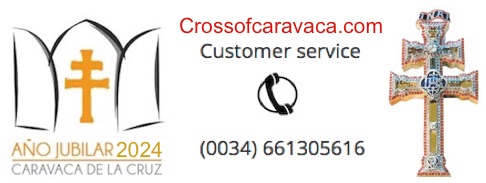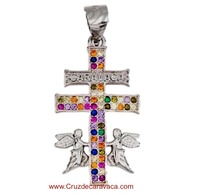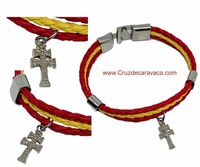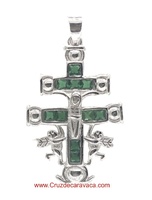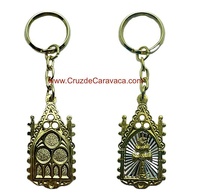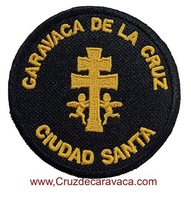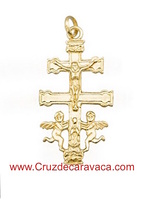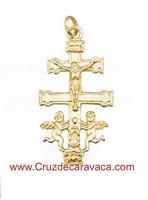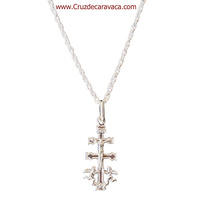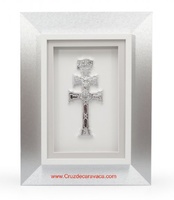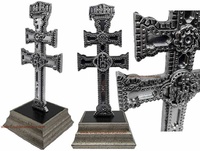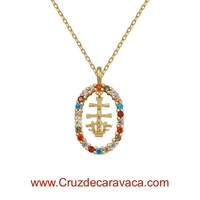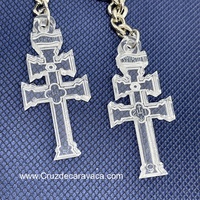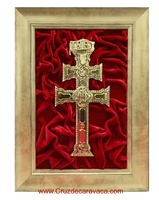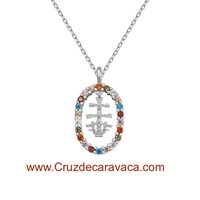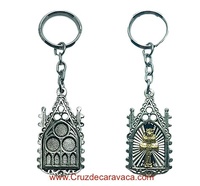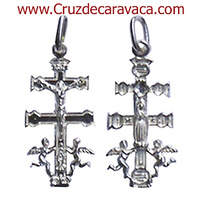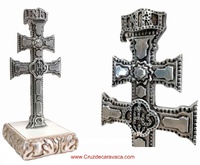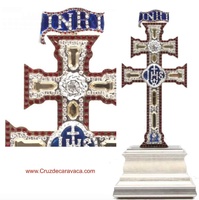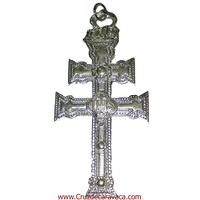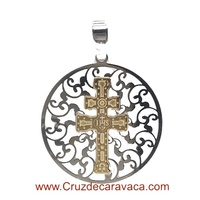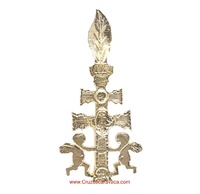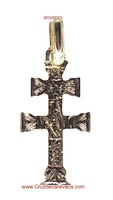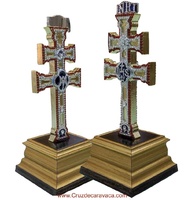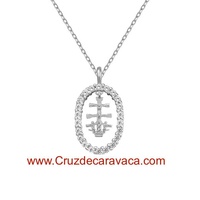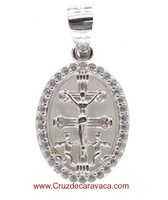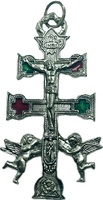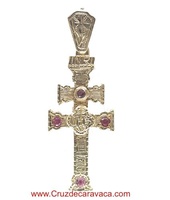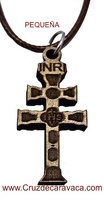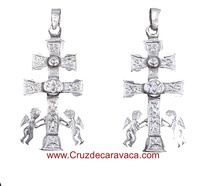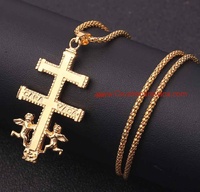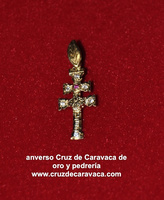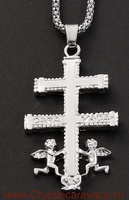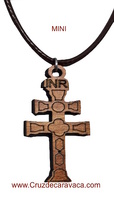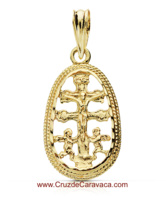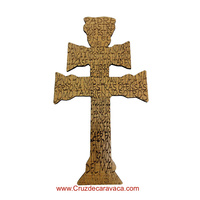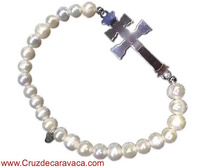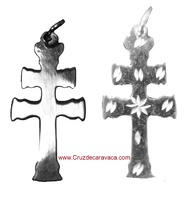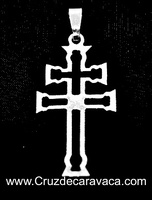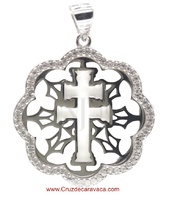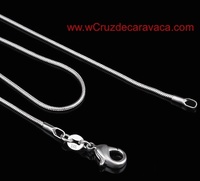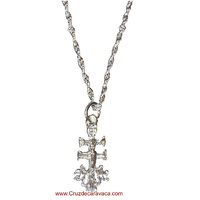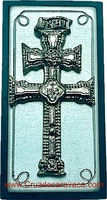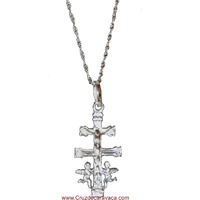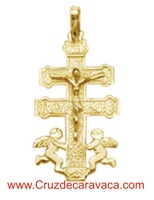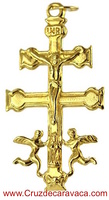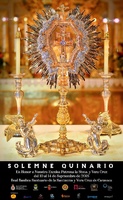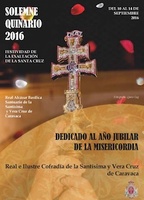Store Cross of Caravaca Online
Specialists in Silver Gold Caravaca Crosses and replicas
TURKISH EYE AND CROCE DI CARAVACA IN BRACELET -CHOICE OF 5 COLORS-
SPRING BRACELETS SET OF 5 EYE TURKISH AND CROSS CARAVACA FIVE ASSORTED COLORS: BLUE, GREEN, BLACK, AMBER, AND RED. THE BRACELETS, THE SPRING BE FIT VA... more ...
from
2,50€
25
CARAVACA CROSS ROSARY WITH METAL ANGELS AND WOODEN BEADS
ROSARY OF THE CROSS OF CARAVACA WITH ANGELS MADE OF METAL, WITH WOODEN BEADS WHERE THE WOODEN BALL OF EACH BEAD IS ENGRAVED WITH A LATIN CROSS. IT HAS... more ...
from
13,00€
9,75€
16
LARGE CARAVACA CROSS WITH ANGELS SILVER PLATED METAL WITH CHRIST AND THE HEART OF JESUS
LARGE CARAVACA CROSS WITH ANGELS MADE OF CAST METAL, ENAMELLED WITH RED AND GREEN AT THE ENDS AND PLATED WITH SILVER. ON ITS OBVERSE SIDE IT HAS THE C... more ...
17,75€
14,95€
SILVER CARAVACA CROSS WITH ANGELS AND COLOURED ZIRCONS
SILVER CARAVACA CROSS RHODIUM PLATED SO IT NEVER GETS BLACK WITH THE TWO ANGELS ON ITS SIDE AND THE LEGEND ‘CARAVACA’ ON THE UPPER ARM, AND THE REST O... more ...
27,75€
BRAIDED BRACELET WITH-CROSS-DE-CARAVACA AND SPANISH FLAG
QUALITY BRAIDED LEATHER BRACELET WITH A METAL CARAVACA CROSS AND ANCHOR-SHAPED METAL ZAMAK CLOSURE. THE BRACELET CONSISTS OF THREE BRAIDED CORDS IN CO... more ...
7,95€
31
KEY RING CROSS OF CARAVACA IN GOTHIC GOLDEN CHAPEL
KEYRING WITH THE CROSS OF CARAVACA IN GOLD COLOUR ON A GOTHIC CHAPEL OF GOLDEN METAL. THE KEY RING HAS A RING FOR A TOTAL OF 6 TO 8 KEYS AND THROUGH ... more ...
from
5,75€
3,95€
EMBROIDERED PATCH OR SHIELD OF THE CROSS OF CARAVACA WITH ANGELS
PRECIOUS GOLDEN THREAD EMBROIDERED SHIELD OF THE CROSS OF CARAVACA WITH DOUBLE ARMS WITH THE WORDS "CARAVACA DE LA CRUZ" IN SEMI CIRCLE AND ALSO "CIUD... more ...
9,95€
12
CARAVACA CROSS WITH ANGELES MADE IN GOLD
PENDANT CROSS OF CARAVACA WITH ANGELS WITH CHRIST ON THE FRONT. MADE IN GOLD OF LAW, 18 KLT. MEASURES 2.4 X 1.1 CMS. PRESENTED IN ITS BOX AND ... more ...
99,75€
87,95€
18
CARAVACA CROSS WITH ANGELES MADE IN GOLD
CARAVACA CROSS PENDANT MADE WITH GOLD ANGELS OF LAW, 18 KLT. MEASURES 3 X 1.2 CMS PRESENTED IN YOUR BOX AND GIFT BAG more ...
145,75€
119,95€
15
SET IN SILVER LACE AND CROSS CARAVACA
IT'S A SILVER AND LACE CROSS CARAVACA EVEN SILVER AND SIDED. THE CROSS PENDANT CARAVACA ANGELES MADE WITH SILVER. IN YOUR FRONT BRINGS THE CHRIST AND... more ...
from
21,75€
18,50€
10
TABLE OF THE CROSS OF CARAVACA WITH SILVER WOODEN FRAME
Picture with the resin caravaca cross with silver metallic bath mounted on white background lacquered glass. The white wooden edge of the frame is als... more ...
105,00€
94,95€
26
REPLICA AUTHENTIC CARAVACA CROSS WITH CARVED WOODEN BASE HOLY YEAR 2024
THIS IS A BEAUTIFULLY CRAFTED REPRODUCTION OF THE MOST HOLY AND TRUE CROSS OF CARAVACA, MOUNTED ON AN AUTHENTIC WOOD BASE CARVED IN RELIEF, WHICH FURT... more ...
100,00€
73,95€
GOLD PLATED STERLING SILVER MEDAL AND CHAIN OF THE CROSS OF CARAVACA WITH COLOURED ZIRCONIAS
PRECIOUS GOLDEN SET OF MEDAL OF THE CROSS OF CARAVACA WITH ANGELS AND CHAIN, MADE OF GOLD PLATED STERLING SILVER WHERE THE CROSS OF CARAVACA IS FRAMED... more ...
33,95€
30
KEYCHAIN CROSS OF CARAVACA METHACRYLATE WITH DETAILS
CARAVACA CROSS KEY MADE IN METAL AND NICKEL PLATED RESIN IN THE FUND. more ...
3,95€
2,75€
16
GOLDEN CARAVACA CROSS TABLE ON VELVET
Picture with Cruz de Caravaca with a golden metal bath mounted on authentic draped red velvet that highlights the Caravaca Cross and which is framed w... more ...
99,75€
83,95€
STERLING SILVER CROSS OF CARAVACA MEDAL AND CHAIN SET WITH COLORS ZIRCONIA STONES
PRECIOUS SET OF MEDAL OF THE CROSS OF CARAVACA WITH ANGELS AND CHAIN, ALL IN STERLING SILVER, WHERE THE CROSS OF CARAVACA IS FRAMED OR CROWNED IN AN E... more ...
31,00€
29
GOLDEN CARAVACA CROSS KEY RING IN SILVER PLATED GOTHIC CHAPEL
KEY RING OF THE CROSS OF CARAVACA IN GOLD ON A GOTHIC SILVER PLATED METAL CHAPEL. THE KEY RING HAS A RING FOR A TOTAL OF 6 TO 8 KEYS AND THROUGH A ME... more ...
from
5,25€
3,75€
16
SILVER CROSS OFCARAVACA CR3
CARAVACA CROSS PENDANT, MADE OF SILVER MEASURES 3,1 X 1.3 CMS. PRESENTED ON YOUR GIFT. more ...
12,75€
10,75€
26
AUTHENTIC CARAVACA CROSS WITH WOOD BASE
BEAUTIFUL REPRODUCTION OF THE STMA AND VERA CRUZ DE CARAVACA, MOUNTED ON AN AUTHENTIC WOODEN STAND CARVED IN RELIEF THAT EVEN INCREASES THIS MAGNIFICE... more ...
95,00€
69,95€
REPLICA CROSS OF CARAVACA WITH SWAROVSKI STONES ON PEANA
WONDERFUL REPRODUCTION OF THE BLESSED AND VERA CRUZ DE CARAVACA, MOUNTED ON PEANE TO RELIEF THAT EVEN INCREASES MORE BEAUTY THIS MAGNIFICENT REPLICA.... more ...
279,00€
20
LARGE DOUBLE-SIDED METAL CROSS OF CARAVACA
LARGE SIZE CARAVACA CROSS MADE IN SILVER PLATED CAST METAL WITH DETAILS IN RELIEF ON BOTH SIDES, THAT IS, IT IS REVERSIBLE AND ON BOTH SIDES IT HAS AL... more ...
18,75€
14,95€
14
CARAVACA CROSS MEDAL IN SILVER AND SILVER GOLD PLATED MODERNIST DESIGN
PENDANT OF THE CROSS OF CARAVACA MADE IN STERLING SILVER THE MEDAL AND STERLING SILVER WITH GOLD PLATED THE CROSS OF CARAVACA CENTRAL. IT IS A NEO MOD... more ...
from
29,00€
24,95€
7
GOLDEN CROSS WITH CHRIST CARAVACA ANGELES TWO SIDES
CARAVACA CROSS WITH ANGELS TO HANG MADE IN GOLD 18 KLT WITH LEAF-SHAPED RING. IT MEASURES 3 CMS IN HEIGHT INCLUDING THE RING AND 1.4 CMS IN WIDTH, WEI... more ...
149,75€
139,00€
25
CARAVACA CROSS 18 GOLD GOLD WORKED ON TWO SIDES
CARAVACA CROSS MADE IN 18K GOLD GOLD, WITH ORNAMENTATION WORK CARVED ON THE TWO SIDES OF THE CROSS OF CARAVACA MEASURES 1.9 CMS. HIGH RING INCLUDED X ... more ...
53,00€
39,95€
REPLICA CROSS OF CARAVACA WITH SWAROVSKI STONES ON A DOUBLE-SIDED BASE
WONDERFUL REPRODUCTION OF THE BLESSED AND VERA CRUZ DE CARAVACA, MOUNTED ON PEANE TO RELIEF THAT EVEN INCREASES MORE BEAUTY THIS MAGNIFICENT REPLICA.... more ...
550,00€
STERLING SILVER CROSS OF CARAVACA MEDAL AND CHAIN SET WITH WHITE ZIRCONIA STONES
VERY NICE SET OF MEDAL OF THE CROSS OF CARAVACA WITH ANGELS AND OF STERLING SILVER CHAIN BOTH THINGS, WHERE THE CROSS OF CARAVACA IS FRAMED OR CROWNED... more ...
31,00€
30
SILVER CROSS OF CARAVACA MEDAL WITH LABEL
MEDAL TO HANG FROM THE CROSS OF CARAVACA MADE OF STRAIGHT SILVER WITH THE CROSS AND THE TWO ANGELS EACH SIDE FRAMED ON A BEAUTIFUL SILVER BORDON AND W... more ...
21,50€
14,95€
33
CRUZ DE CARAVACA DE METAL PLATEADO MEDIANA CON ANGELES CRISTO Y EL CORAZÓN DE JESÚS
CARAVACA CROSS REPLICA OF THE OLD ONES, MADE OF CAST METAL WITH SILVER FINISH, AND ENAMELLED IN RED AND GREEN AT THE ENDS OF THE ARMS OF THE CROSS. TH... more ...
13,00€
8,75€
CARAVACA CROSS IN 18 KTS GOLD WITH RED, GREEN AND BLUE STONES
Cross of Caravaca, MADE IN GOLD LAW AND HANGING ZIRCONS. MEASURES 4 CMS HIGH X 1.8 CM. WEIGHT 2.8 GRAMS WIDE. PRESENTED IN ... more ...
327,00€
19
CROSS OF CARAVACA WOOD CARVED SMALL TO HUNG
CROSS OF CARAVACA HARDWOOD CARVED RELIEF TO TWO FACES WITH MUCH OF THE DETAILS OF THE RELIQUARY OF THE CROSS OF CARAVACA. IT IS PREPARED IN ORDER TO H... more ...
5,75€
4,65€
CROSS CARAVACA WITH ANGELS RELIQUARY IN SILVER
CARAVACA CROSS STERLING SILVER WITH ANGELS PLAYING THE RELIQUARY AUTHENTIC CARAVACA CROSS WHERE CANNED WOOD WHERE JESUS DIED. CROSS RELIEF AND A... more ...
21,95€
GOLDEN CARAVACA CROSS WITH ANGELS WITH MATCHED GOLDEN LACE
GOLDEN BATH METAL CARAVACA CROSS WITH TWO ANGELS PLUS METAL LACE WITH GOLDEN BATH. ON ITS FRONT IT CARRIES A RELIEF DRAWING THAT SIMULATES THE CROSS O... more ...
11,95€
13
CROSS OF GOLD 18 KLTS AND STONE CARAVACA (Zircon)
CROSS OF GOLD 18 CARAVACA KLT TO HANG WITH TWO FACES CUT AND RIBBONS. STONES IN TOTAL 4. MEASURES: 2.4 CMS HIGH, INCLUDING THE RING X 0,9 cm WIDE. WE... more ...
103,00€
89,95€
SILVER-PLATED CARAVACA CROSS WITH ANGELS AND MATCHING CORD
SET OF CARAVACA CROSS WITH SILVER PLATED METAL ANGELS AND 60 CENTIMETRES LONG SILVER PLATED METAL CORD. ON THE FRONT IT HAS A RELIEF DRAWING THAT SIMU... more ...
11,95€
17
CROSS OF CARAVACA OF WOOD CARVED WITH CORD FOR HANGING
CROSS OF CARAVACA HARDWOOD CARVED RELIEF TO ONE FACE WITH MUCH OF THE DETAILS OF THE RELIQUARY OF THE CROSS OF CARAVACA.IT IS PREPARED IN ORDER TO HAN... more ...
4,75€
3,95€
8
GOLDEN CARAVACA CROSS WITH ANGELS AND CHRIST IN MEDAL 2.5 GRAMS OF WEIGHT
THIS GOLD CARAVACA CROSS MEDAL MADE IN 9 KILATE GOLD LAW WITH ANGELS AND CHRIST IS ALL FRAMED WITHIN THE DOUBLE CORD SHAPING THE PENDANT OF THE CARAVA... more ...
217,75€
199,95€
CROSS OF CARAVACA OF WOOD CARVED WITH CORD FOR HANGING
ARAVACA CROSS OF NOBLE WOOD CARVED IN A RELAXATION TO ONE FACE WITH A LARGE PART OF THE DETAILS OF THE CROSS CARAVACA RELATIVES. IT HAS ALSO FOOT. &nb... more ...
17,95€
BRACELET ELASTIC SILVER CARAVACA CROSS AND PEARLS
CROSS BRACELET OF SILVER CARAVACA WITH RHODIUM BATH FOR WHICH IT IS PUT BLACK AND PEARL CULTIVATED. IT IS UNIQUE SIZE BECAUSE THE BRACELET OF PEARLS W... more ...
27,95€
30
CROSS SMALL HAND CARVED CARAVACA SIZE LONG - CRAFTS
SILVER CROSS CARAVACA hand carved by artisans on one side. CARAVACA CROSS THIS IS VERY NICE BILL BECAUSE IT HAS A BEAUTIFUL AND ARE PERFECT PROPORTIO... more ...
from
11,35€
7,95€
20
CARAVACA CROSS SILVER SADDLE WITH TRAPEZOIDAL RING BIG
Cross of Caravaca of silver 925 ml silhouetted with the hollow interior and ring to catch also of silver with trapezoidal form. It is sent presented w... more ...
18,75€
14,95€
SILVER CARAVACA CROSS MEDAL AND STAR ZIRCON CROWN
PENDANT OF THE CROSS OF CARAVACA IN THE SHAPE OF A FIVE-POINTED STAR MADE IN STERLING SILVER THE MEDAL SURROUNDED BY A CROWN OF WHITE ZIRCONIA STONES ... more ...
from
27,95€
33
SILVER CORD 60 CMS LONG
Silver cord with silver tail type 1 mm thick and 60 cms. long. It is sent in your jewelry box presented as a gift. more ...
14,95€
9,95€
10
CARAVACA CROSS AND CHAIN IS ALL SILVER
THIS SET OF SILVER CHAIN AND SILVER CROSS CARAVACA IS VERY NICE. PRICE INCLUDES BOTH. CARAVACA CROSS TAKES ON THE FACE THE CRUCIFIED CHRIST IN HIS... more ...
from
15,00€
13,50€
31
CARAVACA CROSS MAGNET FOR INTERIOR OF CAR OR HOUSE
CARAVACA CROSS IN METAL RELIEF WITH MAGNET FRAMED ON ADHESIVE BASE. THE CARAVACA CROSS IS MADE OF SILVER PLATED CAST METAL ON AN ALUMINIUM BACKGROUND ... more ...
6,50€
4,50€
11
BIG CARAVACA CROSS AND CHAIN IS ALL SILVER
SET OF SILVER CHAIN AND SILVER CROSS CARAVACA VERY LARGE GLOSSY. PRICE INCLUDES BOTH. CARAVACA CROSS TAKES ON THE FACE THE CRUCIFIED CHRIST IN HIS... more ...
from
15,75€
13,95€
GOLDEN CROSS WITH CHRIST CARAVACA ANGELES TWO SIDES
CROSS OF CARAVACA WITH ANGELS TO HANG MADE IN GOLD 18 KLT WITH THE CHRIST RELIEF IN THE FRONT AND IN THE REVERSE THE VIRGIN. MEASURES 2,7 CMS H... more ...
277,00€
CARD FOLDER CROSS OF CARAVACA FOR SIX CARDS
CARDBOARD WITH CROSS OF CARAVACA ENGRAVED TO RELIEF WITH CAPACITY FOR SIX CARDS DISTRIBUTED IN 4 COMPARTMENTS AND 2 MORE IN SECRET POCKETS THAT SERVE ... more ...News cross of caravaca
Cross of Caravaca
News, interesting ...
Do you want to know the meaning of the Cross of Caravaca and buy Caravaca Crosses of gold, silver, metal, wood or authentic relic replicas?
Many faithful who feel the attraction for the Cross of Caravaca and who become customers of our online store Cruzdecaravaca.com because they buy us one or several Crosses of Caravaca in our online store ask us for their meaning or for specific aspects of the attractive history always surrounding the Cruz de Caravaca. We are delighted to answer you, and for all those who want to know more quickly about everything that concerns the Cruz de Caravaca, we make a brief and complete summary below.
The Cruz de Caravaca is a double-arm cross recognized by the Catholic and Roman Church, which is worshiped and worshiped in its basilica that is inside the castle of Caravaca de la Cruz, the city to which they are reciprocally named, which is in the Region of Murcia, in the southeast of Spain.
The Cross of Caravaca, has been granted the title of Santísima and Vera Cruz, in reference to the recognition of the true Cross of Christ conferred by the Catholic Church and therefore as a relic is endowed with a sense of exceptionality for having been in physical contact with the crucified body of Christ. Receive the Cult of Latry by official recognition of the Vatican since the eighteenth century.
The Cruz de Caravaca is endowed with a character of real universality motivated by a triple aspect. On the one hand in its historical aspect, its artistic aspect and finally and more importantly in its devotional or religious aspect, which after centuries of history culminated in the concession of Holy Years in perpetuity every seven years granted by St. John Paul II being Pope .
Due to its historical character, the Cruz de Caravaca is a cross of medieval Eastern and patriarchal origin. There we find the meaning of the double arm of the Caravaca Cross, as tradition places it as the pectoral cross of Patriarch Robert of Jerusalem, in the 13th century. From Jerusalem to Caravaca, we find the Caravaca Cross as a protective relic on land bordering with Muslims, in charge and guardian of the Templars, inhabitants of the fortress castle and who direct through their dance all the lands and people of the region of Caravaca, and from there starts a long history of almost eight centuries of miracles, events, worship, visits to Vera Cruz de Caravaca, the expansion of its cult in Europe and America by religious orders. Papal bulls and Jubilee Years around the Cross of Caravaca make up a succession of facts worthy of study.
Due to its artistic character, the Cruz de Caravaca, has been part of the local identity since its inception because of its representation in the shield of the city, in the rich liturgical silver trousseau of the Cruz de Caravaca that is still used or in the reproductions of the Silver Caravaca Cross that continues to melt until today, Gold Caravaca Crosses, or storm Caravaca Crosses. All these Caravaca Crosses end on the chest of believing people, blessing and protecting their homes and their lives.
The Cruz de Caravaca has always been the object of silversmiths, goldsmiths, cabinet makers and painters who have put the relic in ceramics, stone, jewelry, paintings. etc ... Writers, historians and theologians have reflected the different aspects of the relic in the books of the Cross of Caravaca of prayers or other kinds.
Because of its religious character, the Caravaca Cross is a Lignum Crucis and therefore a relic of the wood log where Jesus Christ died. The sacred wood is covered with a reliquary that is the exterior aspect that we see today. The Cruz de Caravaca was always guarded and kept inside the castle walls. There, in her chapel she is venerated and can be kissed when the priest gives her to worship. Twice a year, on the festivities of May, on the 5th and September the 14th blesses the population from the 4 cardinal points, as it does from the chapel of the conjunros every year, where nature is blessed.
The presence of the Cross of Caravaca for almost 8 centuries has originated up to eleven rites around the relic, which highlights the oldest, that of the blessing of the water by the Cross of Caravaca, which takes place every day May 3 by the afternoon, the day of the Invention of the Holy Cross, as a central act of the celebrations of the Cruz de Caravaca that are always held from May 1 to 5.
Special mention deserves the fact that numerous religious orders founded a house in the city of Caravaca de la Cruz: this was the case with Jeronimos, Claretians, Franciscans or Jesuits, and especially the direct foundations of the two Carmelitan branches, that of San Juan de la Cross for men who visited and lived in Caravaca on several occasions and that of Santa Teresa de Jesús for women, who founded a convent in the city and was linked to the Cruz de Caravaca, even on his deathbed, in his hands, He had a Caravaca Cross that is currently preserved in the Carmelite convent in Brussels.
